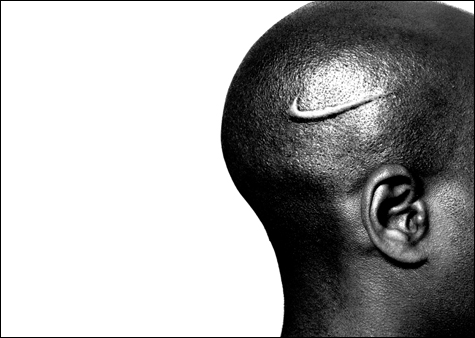Rampant consumerism and Iván Navarro at Tufts, ‘Some Sort of Uncertainty’ at Axiom

BRANDED HEAD: Hank Willis Thomas is one of the few artists at Tufts who doesn’t approach
consumerism with polite resignation.
|
“Branded and on Display” and “Iván Navarro” | Tufts University Art Gallery, 40r Talbot Ave, Medford | Through March 30
“Some Sort of Uncertainty” | Axiom Gallery, 141 Green St, Jamaica Plain | Through February 17
|
One of the laws of the art world is that once you have three exhibitions on the same theme, you can certify it as a trend. So I’d like to declare that art about consumerism is one of the æsthetic trends of our young millennium.
A couple of weeks ago, I wrote about a pair of shows on this theme: “Cornucopia” (at Montserrat College of Art through February 2) and “Ad/Agency” (at Boston University’s Photographic Resource Center through January 27). Now Tufts University Art Gallery has opened “Branded and on Display,” a fun, bright, 22-artist exhibition organized by the University of Illinois’s Krannert Art Museum that addresses how we’re inundated with marketing and addicted to shopping, and how this state of affairs infects everything in our lives.
The artists of “Branded” are both troubled by and enamored of this phenomenon. (I can’t help wondering whether the artistic focus on business isn’t related to mixed feelings of exuberance and anxiety about how the art world itself has been awash in money in recent years.) Their primary tactic is to replicate aspects of advertising, corporate logos, and the retail experience and reflect them back at us.
Laurie Hogan paints monkeys (they feel like evil gremlins) in the colors and with symbols of products found in her home. Ai Weiwei vandalizes an ancient (or so the sign says) pot by painting the Coca-Cola logo around it. Amelia Moore photographs a sea of college kids dressed in matching orange Illini gear at a University of Illinois stadium. Minimalist sculptures by Donna Nield and Clay Ketter mimic the look of furniture and store displays.
Pierre Huyghe offers an affecting digital animation of an alien anime elf girl with big blank eyes. The artist, it seems, bought the rights to the character from a Japanese firm that invents them for the cartoon industry. The cartoon, now existing only for this brief artistic purpose, laments her existence. It’s like some woeful Philip K. Dick yarn.
As the artists present it, all this business and economic stuff is alien and insidious and poisonous, and we’ve been brainwashed. Maybe that’s why they all seem politely resigned. Only a few attempt anything that could ruffle feathers. Michael Blum offers a rambling, earnest video documenting his trek to Indonesia to find the poorly paid workers who made his Nike sneakers. Hank Willis Thomas’s 2003 photo Branded Head shows the cropped profile of an African-American man, the side of his shaved head horrifyingly, hauntingly branded with the Nike swoosh. He implies that black athletes who serve as sneaker pitchmen are akin to slaves.
Is there any way to opt out of our troubling style of capitalism? (The term “capitalism,” I’d like to note, makes nary an appearance in the three exhibits.) The closest we get to an alternative is Yuken Teruya’s ingenious cut-paper dioramas. He collects paper shopping bags (here mostly from high-end boutiques), slices out pieces from one side, and assembles those into exquisite little paper trees standing inside the bags, with dramatic light and shadows filtering through the holes he cut in the bag. They’re philosophical poems about trees turned into paper that then becomes refuse that he fashions into tiny trees. They’re about recycling corporate industrial junk into something exquisite, small, one-of-a-kind, human, handmade. And they’re gorgeous feats of craftsmanship.
Tufts is also presenting a small exhibit of sculptures and videos by Chilean-born New Yorker Iván Navarro that was organized by Tufts University Gallery director Amy Ingrid Schlegel. Navarro has been aping the looks of classic minimalist sculpture in pieces of social criticism. Die Again (Monument for Tony Smith) (2006) re-creates Smith’s landmark six-foot-square steel cube as a looming black walk-in 12-foot-square plywood haunted house of magic mirrors, a Beatles cover (“Nowhere Man,” with female vocals and percussion), and ominous darkness. It’s supposed to be a reflection on the “Desaparecidos” — the “Disappeared” — of Chilean despot Augusto Pinochet’s rule from 1973 to 1990 and the expatriate experience, but it’s hard to tell.
Flashlight: I’m not from here, I’m not from there (2006) is a large black wheelbarrow covered with lit blue fluorescent bulbs (à la Dan Flavin); Homeless Lamp: The Juice Sucker (2005) is a bulky white shopping cart covered with lit white fluorescent bulbs. On their own they’re magnetic (the bright lights attract your eyes but prevent you from seeing them clearly) but inert. They come alive in videos in which men wander city streets or deserted railroad tracks and break into street lamps to steal electricity or siphon gas from a car to fuel a generator to power the sculptures’ lights. They become melancholy meditations on homelessness and poverty, on power and powerlessness.